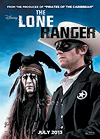
The Lone Ranger, Walt Disney Pictures and Jerry Bruckheimer Films, 149 minutes, 2013
In time The Lone Ranger will be remembered primarily from a fiscal perspective, for being, like 2012’s John Carter, another $250 million failure from the Hollywood summer blockbuster machine. From an aesthetic viewpoint the movie isn’t much better. Disney used too broad a brush with The Lone Ranger. The result is a bloated attempt to entertain mothers, fathers, teens and toddlers, a mess of conflicting tones and styles that ultimately fails to satisfy anyone—Western lovers or otherwise.
It is astonishing to see so much money thrown at a Western in an era when it’s difficult to get a Western made on even the most miniscule budget. But one is able to trace how it came to fruition: It takes director Gore Verbinski, who’s had great success with movies of this scale, reteams him with Johnny Depp, the star of his billion-dollar-grossing Pirates of the Caribbean series, and puts them behind a story that plays much like a superhero film, the dominant genre of the summer blockbuster scene. Like Batman Begins or Iron Man, The Lone Ranger serves as an origin story for our hero. But unlike Batman or Iron Man, this hero (made popular on 1950s television by Clayton Moore) has no relevance for today’s kids and teens and is played by an actor (Armie Hammer) whose best-known role is a supporting one, as the Winklevoss Twins in The Social Network. On top of that it’s a Western. Perhaps Disney realized these logistical shortcomings and tried to offset them by jamming enough into this movie for everyone.
The result is 149 minutes of visual effects, laden mischief that throws everything at you, most conspicuously Depp’s bizarre-looking Tonto (complete with dead crow headdress and a far cry from Jay Silverheels’ yesteryear look). Ironically, not until the film throws in the proverbial kitchen sink, in its action-packed finale, does it truly become enjoyable, as horses jump onto trains, heroes shoot guns from villains’ hands, and the “William Tell Overture” booms from the speakers. The Lone Ranger saves the girl with gusto, and the film finally understands what it is—a kid’s movie. What precedes this belated moment of joy is two long hours of contrived mush.
One can simply look at the violence in the film to see how unsure of itself it is. For instance, the first time we see John Reid as his masked alter ego is during a goofy scene in which he shoots a bullet that ricochets off various surfaces before slicing through a rope that drops a heavy piece of equipment—it might as well have been an anvil—onto the unsuspecting bad guys. It is pure Looney Tunes, and this would have been refreshing, had the film struck this tone throughout. But this “anvil on head” scene is sandwiched between folks getting scalped, Comanches getting massacred and our uninspired baddie, Butch Cavendish (William Fichtner), tearing a heart from a man and eating it. Conflicting tones were an issue with Verbinski’s final Pirates entries as well, which were equally bombastic and lengthy. At times you’re not sure whether you’re watching a Saturday morning cartoon or a Sergio Leone Western.
The latter seems to be an inspiration for Verbinski, who now has two Westerns notched on his résumé. He fills The Lone Ranger with as many references to classic Westerns as he did in his previous film, Rango, an animated tale of a chameleon (Depp again, at least in voice) that was exponentially more delightful. The Lone Ranger soundtrack is filled with nods to Ennio Morricone, and fans of John Ford (The Searchers in particular) will notice visual callbacks. Monument Valley, meanwhile, couldn’t look more beautiful.
The best thing the film has going for it, other than Ford’s iconic Western valley, is the back-and-forth between Hammer’s upright Lone Ranger and Depp’s deadpan Tonto, as well as some silly sight gags involving Silver, the Lone Ranger’s horse. The movie spends far too much time with characters that are devoid of life, like Rebecca Reid (Ruth Wilson), and far too little with characters that show promise, like Red Harrington (Helena Bonham Carter), a brothel owner with a mechanical leg that leaves men drooling. Verbinski completely wastes talents like Tom Wilkinson and Barry Pepper, putting them through nonsensical plot twists in an attempt to conceal their one-dimensionality. One-dimensional characters are forgivable in a summer flick as long as its fun. But fun is spontaneous, an offshoot of originality and wit, two aspects completely absent from this film (even Cavendish’s cardiac extraction isn’t original; see Indiana Jones and the Temple of Doom). The Lone Ranger proves there is no surefire studio formula to ensure “fun for the whole family,” nor is there one to recoup a $250 million budget. Disney is learning that the hard way.
Louis Lalire




